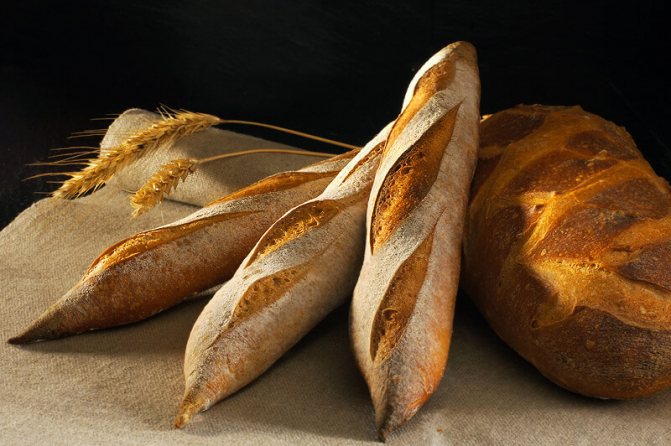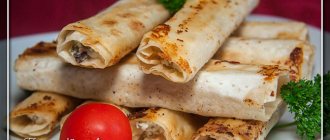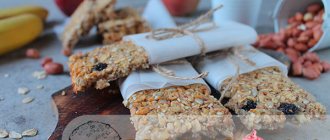Baguette properties
Nutritional value and composition | Vitamins | Minerals
How much does a baguette cost (average price for 1 piece)?
Moscow and Moscow region.
35 rub.
When talking about bread, everyone means their favorite type of flour product. Some people prefer regular black bread, others like a snow-white loaf made from wheat flour, but, you see, few people will refuse a long, narrow, fresh baguette with a golden crust that crunches appetizingly when broken off.
Still, what pleasure we get from the crunch of the baguette crust! And what could be tastier than a breakfast consisting of a cup of coffee and a long baguette tartine, spread with delicate butter and aromatic sweet jam? In addition, there are those who simply cannot live without sandwiches, where fresh tomatoes, bacon or pate form a great combination with a fresh baguette.
Appearing in France at the beginning of the 19th century, over time the baguette acquired the status of a real French emblem. In the minds of foreigners, it is always accompanied by a bottle of dry red wine and a beret. Meanwhile, the importance of the baguette for many of us is not at all exaggerated: it actually represents a distinctive and necessary product on our table. It is difficult to imagine at least one meal without bread, and therefore without this delicate, aromatic product.
According to the most popular version, the culinary history of the baguette began when Austrian bread became known to the French. In those days, it was already distinguished by its elongated shape, but it was made using not the usual pressed yeast, but brewer’s yeast. A distinctive feature of a baguette - a crispy crust - was formed during the baking process of this bread in the oven. Over time, little has changed, except that the composition of the baguette has improved slightly, to which chefs began to add whatever their heart desires, just to please the picky buyer.
Application
This product is eaten with soups and main courses. The baguette is also perfect for making sandwiches or just for breakfast. It can be washed down with milk or tea. But according to tradition, this product is not cut, but simply broken by hand.
Market Analytics
- COVID-19 is changing the rules of the game in the cosmetics market
- Beauty of the future: cosmetic innovations 2020
- New ingredients are the driving force of the cosmetics industry
Convenient search for beauty salons on our website
Beauty salons in Moscow Beauty salons in St. Petersburg Beauty salons in Ekaterinburg Beauty salons in Novosibirsk
Latest blog posts on our website
- Naturecream / Geranium (Pelargonium) oil for skin health and beauty
- Prostye-sovety / Save on a beauty salon: procedures that can be done at home
- Naturecream / Growth Factor - brings back youth?
- Oksana-Lezina / 3 effective abdominal exercises from a fitness instructor for beginners
- Prostye-sovety / Making perfect curls at home
- Prostye-sovety / Which hair removal method to choose
- Naturecream / Wrinkles Puppets
- Naturecream / PEPHA-TIGHT - instant skin lifting
- Naturecream / Blue light - a danger to the skin
- Naturecream / Cocoa Butter – A treat for the skin
Latest forum topics on our website
- Mrs._Smith / Badly sunburned! What to do?((
- Ice / Is it necessary to combine fitness classes with a diet?
- Antonova / What can be used for hair loss?
- Radio operatorKat / Who was on a protein diet?
- Suzanna / Mesotherapy on the face
Other articles in this section
| Baranki The first steering wheel was made in a city called Smorgon, located in Belarus. Initially, the name of this product was “boiled”. It had this name because the product was prepared from scalded dough. And only after a while people called it “steering wheels,” because people believed that the product looked like a ram’s horn. |
| Ciabatta bread Italian cuisine has always been distinguished by its sophistication and originality. Dishes of this cuisine are eaten with great pleasure all over the world. Italians also have special requirements for bread products - they should not overshadow the main course, and at the same time they must be an ideal addition to any dish. |
| Bread with seeds Nowadays, there are many different types of bread. One of them is bread with seeds. Pumpkin seeds and sunflower seeds are added to it, and sesame is also used. Most often, milk and eggs are not used to make this bread. |
| Bread with bran At first, bran was considered suitable only for animal feed; it was steamed and fed to animals for faster weight gain. Thanks to the research work carried out, it was revealed how useful bread with bran obtained after grain processing is. A large number of people know that bran is the husk peeled from grain, but only a few people know why it is useful. It is interesting to know that this is where the largest amount of biologically valuable substances is concentrated - about 90%. |
| Vysivkovy Bread Bread baked with the addition of bran or from whole grain flour is called vysivkovy. The name “vysivkovy” comes from Ukraine - that’s what they call the grain shells there. But more often they are called simpler and more familiar - bran. The first mentions of such bread were found in Ancient Egypt. Vysivkov bread was eaten by people belonging to the simple, poor strata of the population, since this type of bread was the cheapest and most accessible. |
| Rye bread has been baked in Russia and Northern European countries since the mid-9th century. Initially, the recipe was kept strictly secret. Today, rye bread is produced in large batches at bakeries. According to the bread recipe, fermentation elements are added to the dough, making the structure of the bread loose. Bread is baked from dough based on rye flour, water and sourdough. When making it, it is important that the bread is completely baked, otherwise mold will form on it. |
| Chapati In countries such as Pakistan, Afghanistan, Bangladesh, Sri Lanka, Hong Kong, India, chapatti is traditionally served at the table, or, as the locals call it, rootie. These are unleavened flatbreads made from unrefined flour. Chapatis are prepared in different ways: it can be a regular frying pan, karai (round frying pan), tendur (metal barrel coated with clay). They can be similar to our pancakes, thin pita bread or fluffy buns. |
| Rye-wheat bread This composition of bread is considered traditional, and dates back to ancient times, it was then that people realized that such bread as rye-wheat has the most complete optimal balance of all components. This bread was mentioned in ancient manuscripts; healing powers have long been attributed to it, because a mixture of rye and wheat flour is still a valuable recipe for baking. |
| Selyanochka bread Wonderful tasty Selyanochka bread made from oatmeal with the addition of sesame seeds has always been considered the main dish and decoration of any table. In addition to excellent taste, the manufacturers of this bread pay considerable attention to its appearance. And everyone knows that looking appetizing is half the battle. |
| Gornyatsky bread Gornyatsky bread can be called a relatively new variety. His recipe was created in 2000 at the Zheleznogorsk bakery. In a fairly short period of time, this variety has become one of the plant’s signature products. |
Baguette composition
Meanwhile, the main ingredients for making this traditional French bread are water, premium wheat flour, salt and yeast. This is the classic composition of a baguette. In addition, the French baguette has certain parameters: with a weight of 250 grams, it has classic parameters: length - 65 cm, width - 5 cm, and thickness - 4 cm. In order to check the quality of the finished product, just press the baguette with your finger – it should quickly acquire its original shape.
Today there are a large number of varieties of baguette. This is due to the fact that bread consumption in general is gradually declining, so bakers are having to get creative to attract more and more baguette lovers. They create a completely diverse new product: poppy seed baguette, rustic baguette, sesame baguette, traditional baguette... In general, they add the most popular and beloved components to the recipe for making a classic baguette. By the way, the calorie content of a baguette is 262 kcal per 100 grams.
Historical reference
There are several versions of how exactly the first baguette was “born”. So, one of the theories says that its “inventor” was a businessman from Austria, August Tsang. He became famous by opening the first steam bakery in the French capital in 1839. Bread here was baked on bricks that were heated by natural gas. It was thanks to Tsang that the first croissants appeared in Paris - however, at that time they were called “kipfel” and were positioned as traditional Viennese pastries. Some historians suggest that “lanky” bread was also first baked in the bakery of an enterprising Austrian - among its assortment there were elongated loaves, in the preparation of which not ordinary yeast, but beer yeast was used.
There is another rather strange version, which says that the elongated loaf is the idea of Napoleon’s bakers. The emperor gave them the task of coming up with a bread that soldiers could comfortably carry with them while on foot. As a result, the bakers allegedly baked a long, thin baguette, which the soldiers were asked to put in a narrow pocket that ran down the entire leg of their trousers. Certain doubts that this theory corresponds to reality arise if you try to imagine what the unfortunate baked goods will look like after the first day of travel.
The baguette in its modern form began to be sold in Paris after the First World War. Its appearance in the assortment of French bakeries was associated with the struggle of workers for their rights.
The thing is that preparing ordinary baked goods - tall round bread - was an extremely labor-intensive and time-consuming process. First, the yeast dough was kneaded, then it had to stand and rise. As a result, in order for residents of the French capital to be able to buy fresh pastries for breakfast, bakers had to start their working day late at night, around two o’clock in the morning. Outraged bakers organized protests, which resulted in the adoption of a law in 1919, according to which bakers were prohibited from starting work before four in the morning. With a few hours left before the bakeries opened, they just had time to bake baguettes. The technology for preparing this type of bread took much less time - the long narrow loaf was low, the dough rose quickly.
In the eighties of the last century, the baguette “lost its ground.” Buyers complained that the bread was not very easy to carry and that it became stale too quickly. Trying to find a way out of their situation, some bakeries began to use simplified technology for baking bread, as a result of which production became cheaper, but the taste was spoiled.
On September 13, 1993, the cabinet of ministers of Edouard Balladur adopted the so-called “bread” decree, which established clear standards for the production of the “traditional French baguette.” It noted that only four ingredients need to be used to prepare this bread: water, grain flour, brewer's or regular yeast and salt. Bread that contained other ingredients automatically lost the right to bear the proud name “baguette”.
It is noteworthy that after bakeries returned to using the traditional recipe, the popularity of baguettes began to grow.
Contraindications
Let us note that despite its popularity and wonderful taste, the baguette cannot boast of any particular health benefits. Like any other bread made from premium flour, it is high in starch and contains mostly “empty” calories. Nutritionists believe that those who are too fond of baguettes run the risk of malfunctioning the gastrointestinal tract, endocrine and cardiovascular systems, and even cancer.
It is extremely important to “combine” baguette and other products correctly. This bread absolutely does not go well with fatty and smoked “delicacies”.
Baguette baked with cheese and ham

Brown, crispy baked baguette with ham and cheese is a delicious and convenient weekend recipe. You can take it on a picnic or serve it with tea. You can change the filling and shape of the bread to your liking.
Ingredients:
- Baguette - 1 pc.
- Garlic - 2 cloves
- Processed cheese - 1 pc.
- Sour cream - 3 tbsp
- Semi-hard cheese –100 g
- Mayonnaise - 1 tbsp
- Ham – 300 g
- Tomato - 1 pc.
- Parsley - for decoration
Step-by-step preparation:
- Cut a long baguette in half, then lengthwise into two parts. You will get 4 servings, from which remove all the crumb. It won’t be useful for the recipe, but don’t throw it away, but dry it in the oven and grind it in a meat grinder. Then you will get breadcrumbs.
- Processed cheese and ? Grate some of the semi-hard cheese.
- Chop the garlic cloves.
- Finely chop the tomatoes.
- Chop the ham into cubes.
- Chop the greens.
- Combine all ingredients for the filling, add sour cream and mayonnaise and mix.
- Fill the baguette with the prepared filling and sprinkle the remaining grated cheese on top.
- Heat the oven to 200 degrees and bake the baguette with cheese and ham for 20 minutes.
Manufacturing technology
The classic recipe for making a French baguette, approved by the same decree of the Cabinet of Ministers, looked like this: a dough of water, flour and yeast had to stand in a warm place for twenty minutes. After this, salt, water and flour are added. The dough is kneaded for ten minutes, then it is infused for about forty-five minutes. Long thin loaves are formed, three cuts are made on each, after which they stand under a damp cloth for about forty minutes to rise properly. Baguettes are baked in the oven for a quarter of an hour.
Interesting Facts

There are many interesting facts associated with the French baguette. Here are just a few of them:
- It is not customary to cut a baguette. They break it, and then cut it in half with a knife and spread it with butter and jam. True gourmets have mastered the art of dipping a baguette with butter and jam crust into coffee - they believe that this is the only way to fully reveal the taste of this bread.
- The baguette almost prevented the launch of the legendary hadron collider. After the temperature began to rise in one of the installation’s compartments, the launch was urgently interrupted. After examining the problem area, scientists found a piece of baguette there. It is believed that it was carried inside the collider by a bird. However, there is another version: that some of the scientists had a snack right at their workplace.
- During a period of sharp decline in the popularity of “lanky” loaves, fashion designer Jean-Paul Gaultier released a special collection of outfits made from bread, aimed at popularizing the baguette.
- Today in Paris, about 500 thousand baguettes are baked every day. More than ten billion baguettes are baked and eaten throughout France every year. This means that on average, each compatriot Alexandre Dumas gets a baguette for two days.
How to prepare baguette filling:
While the dough is rising, cut 100 g of butter into small pieces, place in a small deep bowl and melt on the stove or in the microwave.
Wash and dry basil greens (20 g), peel 6 cloves of garlic. Pour melted butter into a blender bowl, add herbs, garlic cloves and 1/3 tsp. salt. Puree the filling for about 15-25 seconds, turning on the blender at full power. Grate 100 g of hard cheese (Parmesan) on a fine grater.
Forming baguettes
Knead the risen dough, place it on a floured countertop and cut it into 2 pieces with a sharp knife. Cover one half of the dough with a towel and set aside, and roll the other half into a rectangle measuring approximately 25x40 cm. Evenly brush the rolled out dough with half of the green sauce made from butter, basil and garlic using a silicone pastry brush. Next, sprinkle the future baguette evenly with half of the grated cheese. Roll the dough with the filling into a roll. Transfer the resulting roll onto floured parchment and use a sharp knife to cut the roll in half lengthwise, leaving about 4 cm short of the end.
If you love baking with yeast dough, I recommend the following recipes:
To form a baguette, the cut halves of the roll must be placed overlapping each other, turning them slightly so that the cut with the filling is at the top. Thus, wrap the halves of the roll around each other in a spiral to form a baguette. Pinch the ends of the dough and tuck them under the baguette. Place a heat-resistant container with water on the lower level of the oven (I use a small saucepan or baking dish for this purpose) and turn on the oven to heat up to 225 C. The water in the container, under the influence of the high temperature of the oven, will begin to evaporate - and a baguette baked in a humid environment will turn out with a real crispy crust. If you have an oven with steam (factory function), then use it. Carefully transfer the resulting baguette with parchment to a cold baking sheet (I place the baguette on the baking sheet diagonally - it won’t fit any other way), if desired, brush with beaten egg or milk using a pastry brush and leave to rise for about 20 minutes while the oven preheats. During this time, you can form a second baguette using the method described above. Bake the baguette for about 15-20 minutes until golden brown. Cool the finished baguettes a little on a wire rack, if possible.








